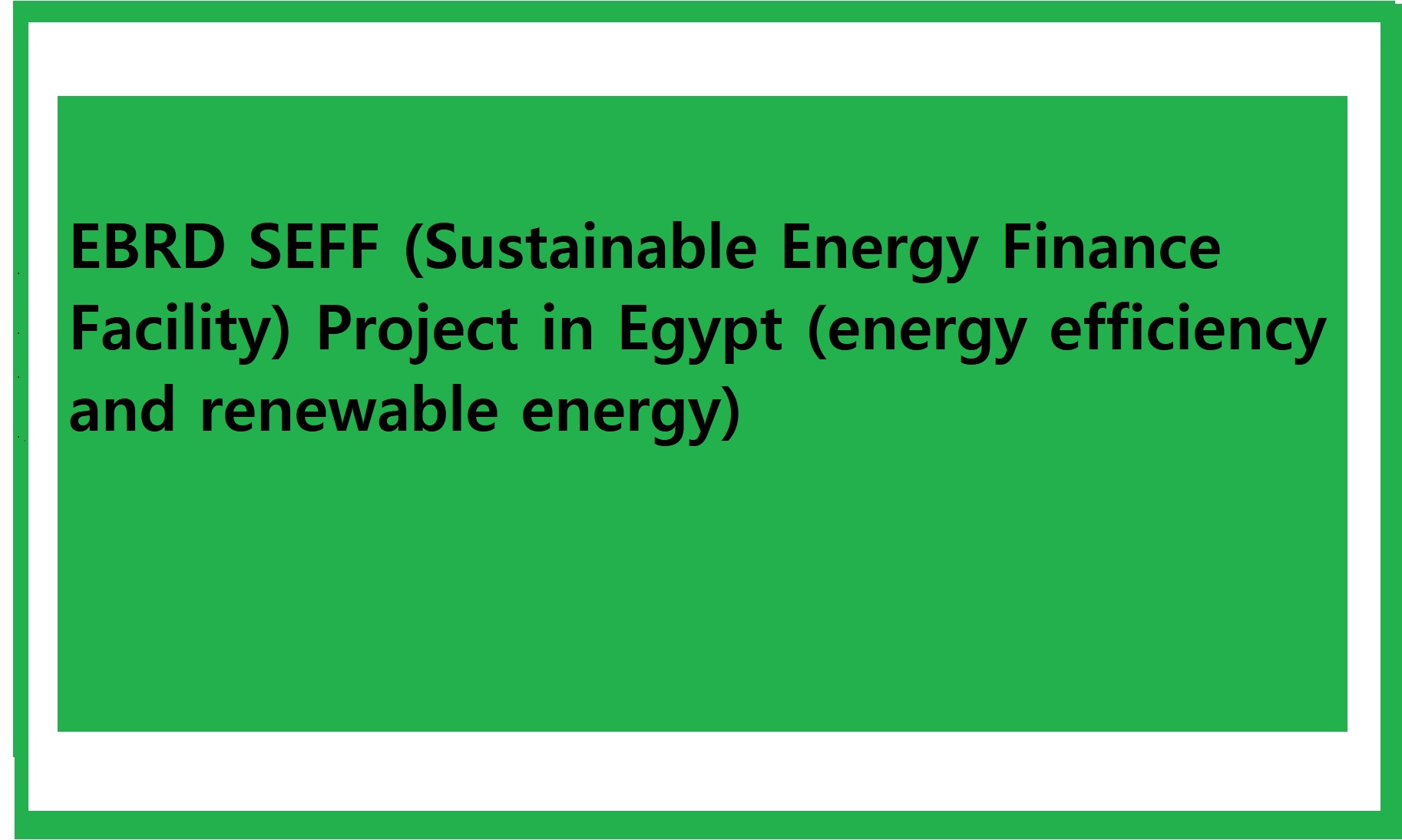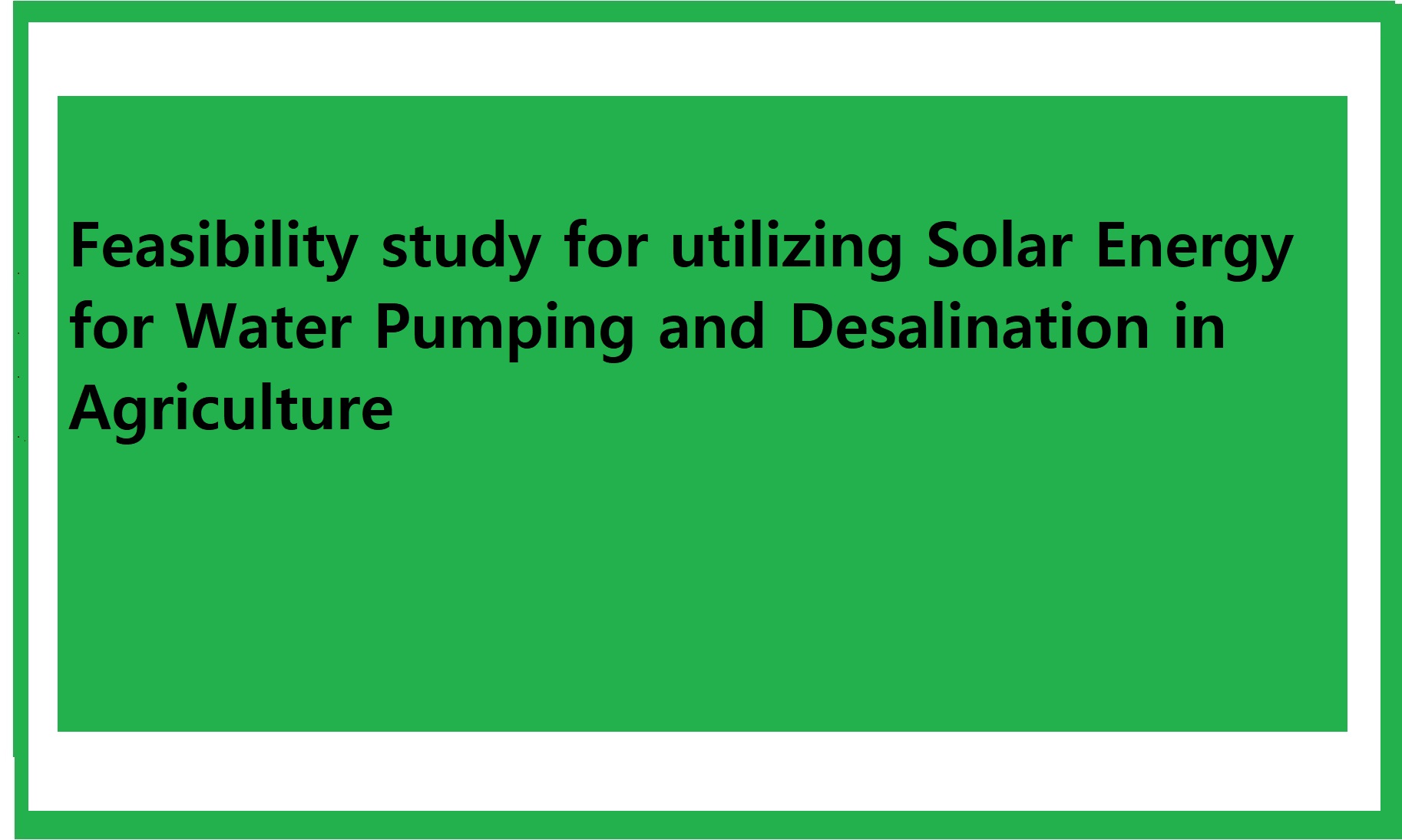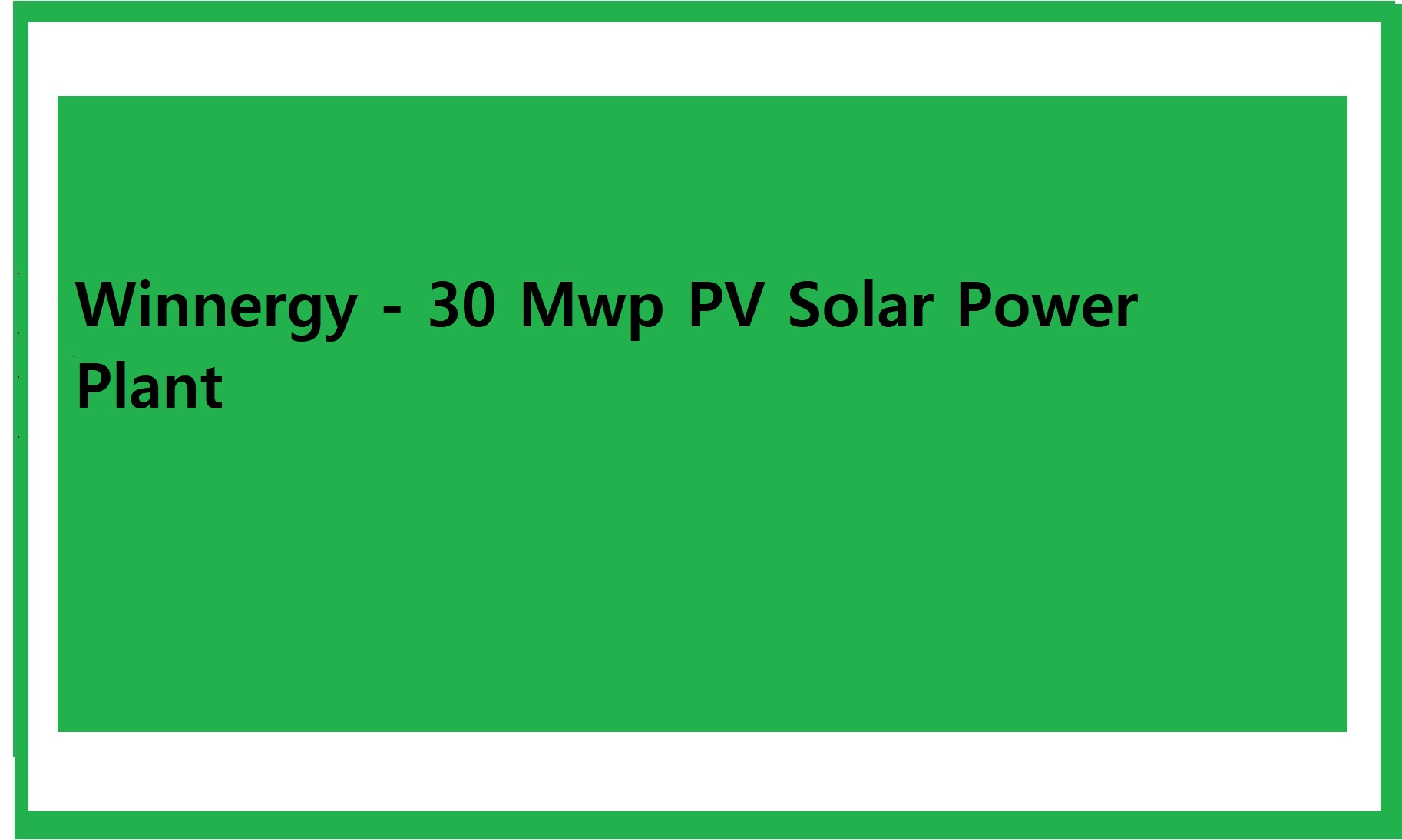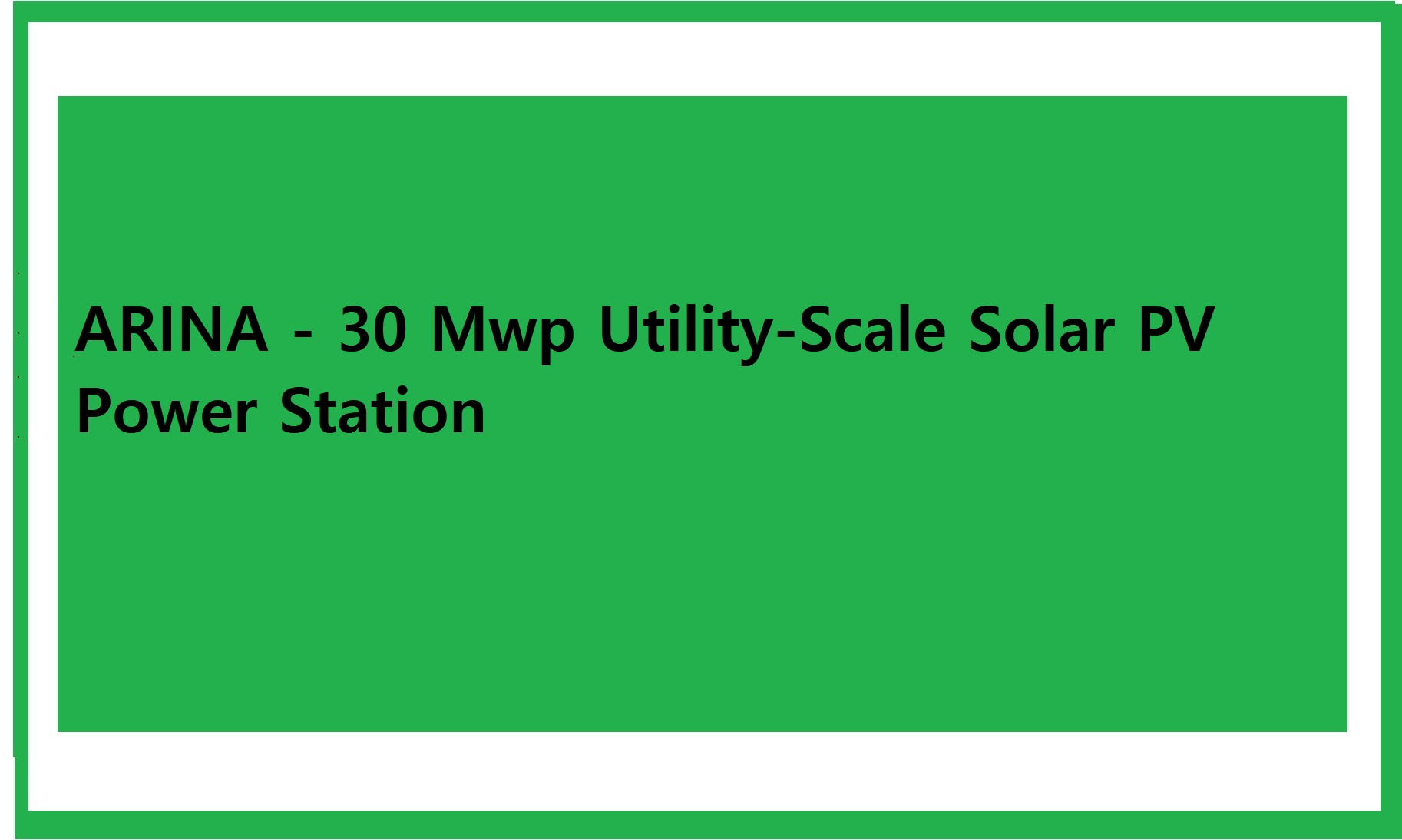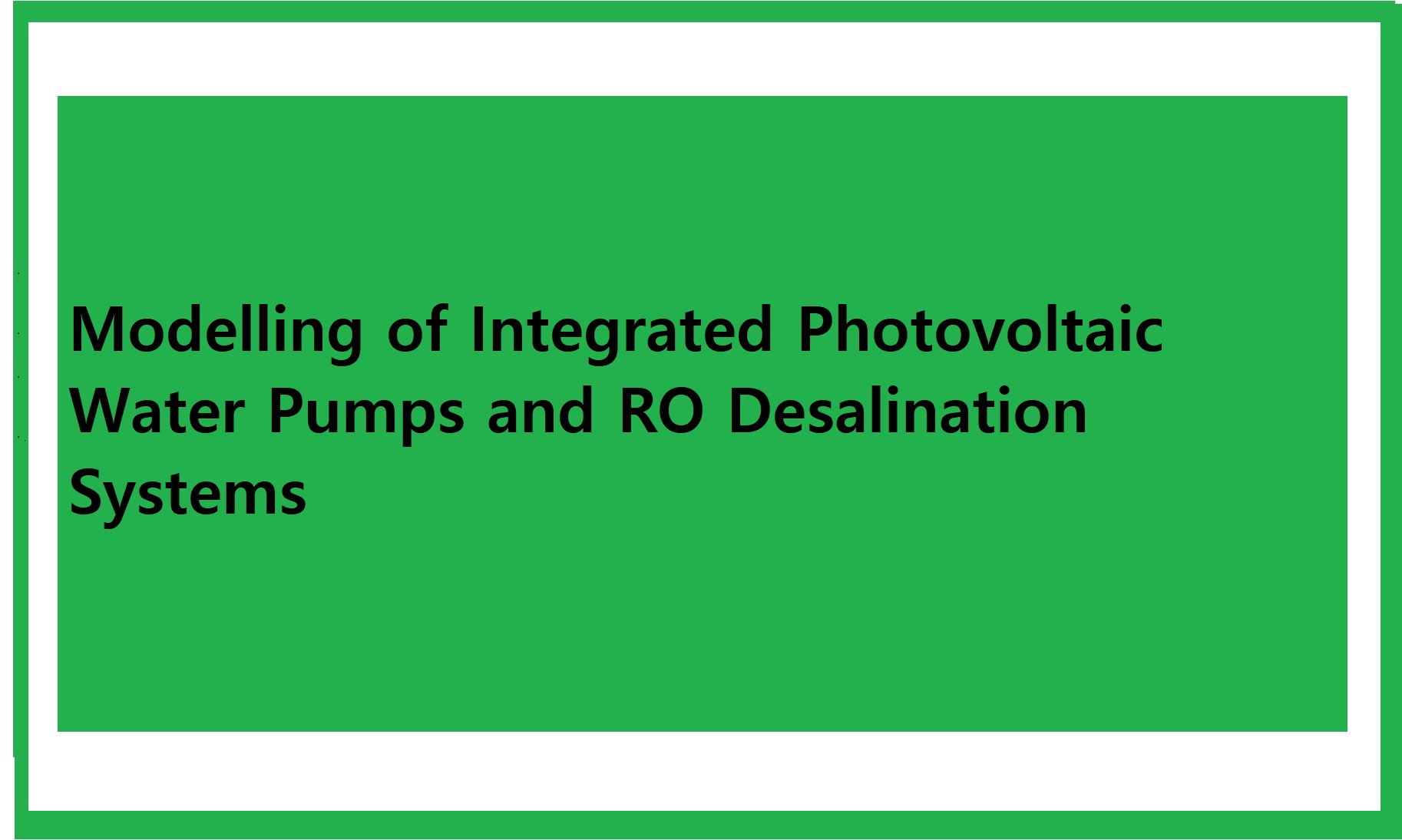
Overview
System Modelled
The model in total had 44 parameters and 19 inputs entered to the deck file and 65 outputs resulted from the simulation process.
The
system under study (figure .1) consists of (i) a power supply, (ii) a
DC/AC inverter, (iii) an AC induction motor, (iv) a centrifugal pump, (v) a
well, (vi) a water storage tank, (vii) an overflow protection device and (viii)
a water desalination system. Each component of the system has been modeled separately and interconnected with other components via a series of inputs and
outputs. The model simulates water pumping and water desalination systems
powered by PV via a DC/AC inverter. Based on the DC control algorithm of the
inverter used, the model simulates constant voltage tracking, voltage frequency
modulation and maximum power point tracking algorithms. For the AC control
algorithm of the inverter used, the model simulates “variable inverter
frequency, variable motor efficiency”; “variable inverter frequency, constant
motor efficiency”; and “constant inverter frequency, variable motor efficiency
algorithms”. The model also simulates grid-connected and diesel-powered water
pumping and water desalination systems. Systems coupled with a variable speed
drive can also be simulated.

Figure 1. System
components and power supply options
A Transient Simulation Program (TRNSYS)
TRNSYS was used to (i) enable all simulation options to be undertaken, (ii) consider transient and steady-state conditions and (iii) to easily update the simulation program for any further system development. TRNSYS’s modular structure enables the user to use “components” available in its library or to program and add newly developed components. A standard component, generally, consists of fixed parameters, and variable inputs, which could be outputs of other components and groups of outputs. A system is structured using a set of components interconnected in such a manner to execute a specific task designed by the programmer. A special program called a deck file is prepared by the user in which all components’ parameters are entered and controlled during the simulation. The deck file also manages the inputs and outputs of each component. In this work, Component Type 94 “PV Array” available in the TRNSYS library was modified to include a newly developed correlation for PV temperature and to simulate different types of inverter algorithms. Component Type 9 “Card Reader”, Component Type 25 “Printer”, Component Type 26 “Plotter” and Component Type 16 “Solar Radiation Processor” were also used from the TRNSYS library. Newly developed Components were: Type 101 “Water Pumping Subsystem”, Component Type 103 “Water Storage Tank” and Component Type 104 “Water Desalination Unit”. A TRNSYS deck file was developed to control the simulation of all Components. The model in total had 44 parameters and 19 inputs entered to the deck file and 65 outputs resulted from the simulation process.
Inputs, Parameters and Outputs
Table 1. Description of Parameters for Component Type 94 “PV Array”
Parameter
|
Description |
Symbol |
|
1 |
Module short-circuit current at reference
conditions (A) |
Isc,ref |
|
2 |
Module open-circuit voltage at reference conditions
(V) |
Voc,ref |
|
3 |
Reference temperature (usually 298 K) (K) |
Tc,ref |
|
4 |
Reference insolation (usually 1000 Wm-2)
(Wm-2) |
GSTC |
|
5 |
Module voltage at maximum power point, reference
conditions (V) |
Vmp,ref |
|
6 |
Module current at maximum power point, reference
conditions (A) |
Imp,ref |
|
7 |
Temperature coefficient of short-circuit current,
reference conditions (AK-1) |
μIsc,ref |
|
8 |
Temperature coefficient of open-circuit voltage,
reference conditions (VK-1) |
μVoc,ref |
|
9 |
Number of cells wired in series in module (often 36
for crystalline 12 V) |
Ns |
|
10 |
Number of modules in series in array |
NS |
|
11 |
Number of modules in parallel in array |
NP |
|
12 |
Module temperature at NOCT conditions (K) |
TC,NOCT |
|
13 |
Ambient temperature at NOCT conditions (usually 293
K) (K) |
Ta,NOCT |
|
14 |
Insolation at NOCT conditions (usually 800 Wm-2)
(Wm-2) |
GT,NOCT |
|
15 |
Individual module area (m2) |
A |
|
16 |
Transmittance-absorptance product at normal
incidence. > 0: the given value
will be used for all angles of incidence.
< 0: the magnitude of the given value will be used for normal
incidence and the incidence angle modifier correlation will be used for all
other angles |
τα norm |
|
17 |
Semiconductor band gap (1.12 eV for silicon PV modules) (eV) |
εg |
|
18 |
Module series resistance. > 0: Rs is parameter No. 18 and should
not be recalculated. < 0: Rs is unknown and should be calculated (Ω) |
Rs |
|
19 |
Slope of I-V curve at short-circuit reference
condition < 0: five-parameter thin film model. > 0: four parameter
single/polycrystalline model (AV-1) |
(dI/dV)v=0 |
|
20 |
A parameter referring to the DC side control
algorithm of the inverter. =1: constant voltage tracking, =2: voltage
frequency modulation |
INVMODE |
|
21 |
Minimum inverter voltage for equation V=V0+V1f (V) |
V0 |
|
22 |
First order coefficient for equation V= V0+V1f (VHz-1) |
V1 |
Table 2. Description
of Inputs for Component Type 94 “PV Array”
|
Input |
Description |
Symbol |
|
1 |
Total incident insolation on an inclined plane (kJm-2hr-1) |
GT |
|
2 |
Ambient temperature (°C) |
Ta |
|
3 |
Load voltage (V) |
V |
|
4 |
Flag for convergence promotion algorithm in direct-coupled
systems. Flag = 0 to disable
algorithm. Flag ≠ 0 to activate
algorithm |
Flag |
|
5 |
Slope of PV array (degrees) |
β |
|
6 |
Beam insolation (kJm-2hr-1) |
GT,beam |
|
7 |
Diffuse insolation (kJm-2hr-1) |
GT,diff |
|
8 |
Angle of incidence for beam insolation (degrees) |
θ |
|
9 |
System frequency (Hz) |
f |
Table 3. Description of Outputs for Component Type 94 “PV Array”
|
Output |
Description |
Symbol |
|
1 |
Array voltage (V) |
V |
|
2 |
Array current (A) |
I |
|
3 |
Power at voltage tracking operation (W) |
PPV,VT |
|
4 |
Power at maximum point along power-voltage curve (W) |
PPV,M |
|
5 |
Fraction of maximum power utilized (for systems without maximum
power-point tracking) |
P/(Vmp Imp) |
|
6 |
Voltage at maximum power point (V) |
Vmp |
|
7 |
Current at maximum power point (A) |
Imp |
|
8 |
Open-circuit voltage (V) |
Voc |
|
9 |
Short-circuit current (A) |
Isc |
|
10 |
Array fill factor |
FF |
|
11 |
Cell temperature (K) |
TC |
Table 4. Description
of Parameters for Type 101 “Water Pumping Subsystem”
|
Parameter |
Description |
Symbol |
|
1 |
Well static head (m) |
hst |
|
2 |
The second order coefficient
of the well system head-flow rate profile H = hst + C4Q2 (sec2m-5) |
C4 |
|
3 |
Reference frequency at
which the head-flow and efficiency-flow data files are given (Hz) |
NR |
|
4 |
Maximum system frequency (Hz) |
NMAX |
|
5 |
Shaft power at
shut off condition at reference speed. If not given by the user, it can be
calculated by the programme (W) |
PO |
|
6 |
Nominal design flow rate
of the pump (m3hr-1) |
QN |
|
7 |
Total area of PV array (m2) |
APV |
|
8 |
Motor efficiency at
maximum system frequency (%) |
ηM,R |
|
9 |
Water storage tank size (m3) |
S |
|
10 |
Inverter efficiency |
ηINV |
|
11 |
Zero order coefficient for
motor equation Pm-out = f(Pinv) (W) |
m0 |
|
12 |
First order coefficient
for motor equation Pm-out = f(Pinv) |
m1 |
|
13 |
Second order coefficient for motor equation Pm-out=f(PINV) (W-1) |
m2 |
|
14 |
Inverter type
(1=MPPT, 2=VT) |
INVTYPE |
|
15 |
A compensation factor for
PV losses |
LOSSPV |
|
16 |
A factor determining the
power supply:1= public grid and diesel generator (const motor efficiency), 2=
PV and inverter or using variable speed drives (variable motor efficiency) |
POWERS |
|
17 |
Motor efficiency at rated
power (%) |
ηM |
|
18 |
Rated motor input power
(W) |
PM,RATED |
Table 5. Description
of Inputs for Type 101 “Water Pumping Subsystem”
|
Input |
Description |
Symbol |
|
1 |
Motor
output power (only when given
externally) (W) |
PM |
|
2 |
Inverter
output power (only when given externally) (W) |
PINV |
|
3 |
Maximum
PV power – output No. 4 of Type 94 (W) |
PPV,M |
|
4 |
In-plane
insolation - output No.7 of Type 16 (KJm-2hr-1) |
GT |
|
5 |
Water
volume in the tank- output No. 1 of Type 103 (m3) |
TV |
|
6 |
Voltage
tracking PV power – output No. 3 of Type 94 (W) |
PPV,VT |
Table 6.
Description of Outputs for Component Type 101 “Water Pumping Subsystem”
|
Output |
Description |
Symbol |
|
1 |
Pump speed (Hz) |
N |
|
2 |
Motor output power (W) |
Pm-out |
|
3 |
Pump flow rate (m3 hr-1) |
Q |
|
4 |
Total pumping head (m) |
H |
|
5 |
Pump efficiency (%) |
ηP |
|
6 |
Hydraulic power (W) |
PHYD |
|
7 |
Mechanical motor power used
by the pump (W) |
PMECH |
|
8 |
Error and/or warning
messages (0,1,2,3,4) |
Error |
|
9 |
The zero order coefficient
of the curve H = A0+A2Q2 (m) |
A0 |
|
10 |
The second order
coefficient of the curve H = A0+A2Q2 (s2 m-5) |
A2 |
|
15 |
Shaft power at shut off
condition at reference speed (W) |
PO |
|
16 |
Motor output power when
maximum frequency is exceeded (W) |
PM,R |
|
17 |
Inverter output power when
maximum frequency is exceeded (W) |
PINV,R |
|
18 |
PV power when maximum
frequency is exceeded (W) |
PPV,R |
|
19 |
Subsystem efficiency when
maximum frequency is exceeded (%) |
ηSUB,R |
|
20 |
Inverter output power (W) |
PINV |
|
21 |
Subsystem efficiency (%) |
ηSUB |
|
22 |
Motor efficiency (%) |
ηM |
|
23 |
Motor efficiency when
maximum frequency is exceeded (%) |
ηM,R |
|
24 |
PV efficiency (%) |
ηPV |
|
25 |
System efficiency (%) |
ηSYS |
|
26 |
Motor power when electric
grid is used as a power supply (W) |
PM,G |
|
30 |
The zero order coefficient
of the curve EP=f(Q) (%) |
E0 |
|
31 |
The first order coefficient
of the curve EP =f(Q) (%s m-3) |
E1 |
|
32 |
The second order
coefficient of the curve EP =f(Q) (%s2 m-6) |
E2 |
|
33 |
The third order coefficient
of the curve EP =f(Q) (%s3 m-9) |
E3 |
|
34 |
PV power (W) |
PPV |
|
35 |
Power required to start
water delivery to the surface (W) |
PREQ |
|
37 |
Water volume in the tank (m3) |
TV |
|
38 |
Surplus PV power when NMAX
is reached (W) |
PNMAX |
|
39 |
Unused PV power when tank
is full (W) |
PLOSS |
|
40 |
Un-pumped water flow rate
when tank is full (m3hr-1) |
QLOSS |
|
41 |
Accumulated PNMAX
(MJ) |
PNMAX,A |
|
42 |
Accumulated PLOSS
(MJ) |
PLOSS,A |
|
43 |
PV output power that is
used by the inverter (W) |
PPV,IN |
|
44 |
Accumulated QLOSS
(m3) |
QLOSS,A |
|
45 |
In-plane insolation (Wm-2) |
GT,W |
|
Parameter |
Description |
Symbol |
|
1 |
Storage
tank maximum capacity (m3) |
S |
|
2 |
Lowest
permitted storage capacity in the tank (threshold) (m3) |
L |
|
Input |
Description |
Symbol |
|
1 |
Water flow rate of the pump
entering the storage tank (m3hr-1) |
QINP |
|
2 |
Water flow rate used by the demand
side (m3hr-1) |
QOUT |
|
Output |
Description |
Symbol |
|
1 |
Hourly
water volume status in the tank (m3) |
TV |
|
2 |
Potential
surplus water flow rate when the tank is full (m3hr-1) |
SW |
|
3 |
Deficit
water flow rate (m3hr-1) |
DW |
|
4 |
Accumulated
surplus water volume (m3) |
SW,A |
|
5 |
Accumulated
water deficit volume (m3) |
DW,A |
Table 10. Description of Parameters
for Component Type 104 “Water Desalination Unit”
|
Parameter |
Description |
Symbol |
|
1 |
Recovery
ratio (%) |
RR |
|
2 |
Energy
consumption per cubic meter of permeate (MJm-3) |
SEC |
Table 11. Description
of Inputs for Component Type 104 “Water Desalination Unit”
|
Input |
Description |
Symbol |
|
1 |
The surplus part of the PV power that is not used by the system when
the maximum speed of the pump is exceeded (W) |
PNMAX |
|
2 |
PV power that is not used by the system when the storage tank is full
and the pump is turned off (W) |
PLOSS |
Table 12. Description
of Outputs for Component Type 104 “Water Desalination Unit”
|
Output |
Description |
Symbol |
|
1 |
Permeate
flow rate when PNMAX is used as the input power (m3hr-1) |
QPNMAX |
|
2 |
Brine
flow rate when PNMAX is used as the input power (m3hr-1) |
QBNMAX |
|
3 |
Required raw water flow rate input to the desalination unit when PNMAX
is used as the input power (m3hr-1) |
QRNMAX |
|
4 |
Permeate
flow rate when PLOSS is used as the input power (m3hr-1) |
QPLOSS |
|
5 |
Brine
flow rate when PLOSS is used as the input power (m3hr-1) |
QBLOSS |
|
6 |
Required raw water flow rate when PLOSS is the input power (m3hr-1) |
QRLOSS |
|
7 |
Permeate
flow rate from both QPLOSS and QPNMAX (m3hr-1) |
QP |
|
8 |
Brine
flow rate from both QBLOSS and QBNMAX (m3hr-1) |
QB |
|
9 |
Required
raw water flow rate to produce QPLOSS + QPNMAX (m3hr1) |
QR |
|
10 |
Accumulated
QPNMAX (m3) |
QPNMAX,A |
|
11 |
Accumulated
QPLOSS (m3) |
QPLOSS,A |
|
12 |
Accumulated
QP (QPNAMX,A+QPLOSS,A) (m3) |
QP,A |
Other Data Files Required
The
data files required by the model are:
·
Head-flow
rate characteristics of the pump at reference speed. Component Type 101 “Water
Pumping Subsystem” requires this file. Data points can be obtained from
manufacturers’ datasheets or from laboratory tests
·
Efficiency-flow
rate characteristics of the pump at reference speed. This file is required by
Component Type 101 “Water Pumping Subsystem”. Data points can be obtained from
manufacturers’ datasheets or from laboratory tests
·
Insolation
and ambient temperature data: Insolation
is used as input for Component Type 16 “Radiation Processor” via Component Type
9 “Card Reader”. Outputs of Component Type 16 are used as inputs to Component
Type 94 “PV Array”. Ambient temperature data is used by Component Type 94 “PV
Array” via Component Type 9 “Card Reader”.
·
Demand data
file containing hourly flow rate over the day. It is used as input to Component
Type 103 “Water Storage Tank” via Component Type 9 “Card Reader”.
